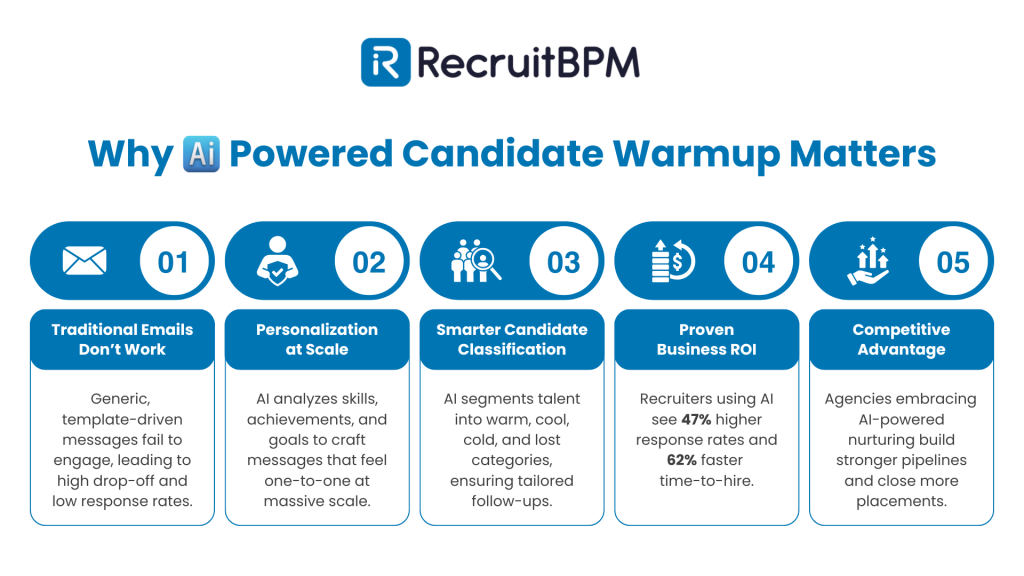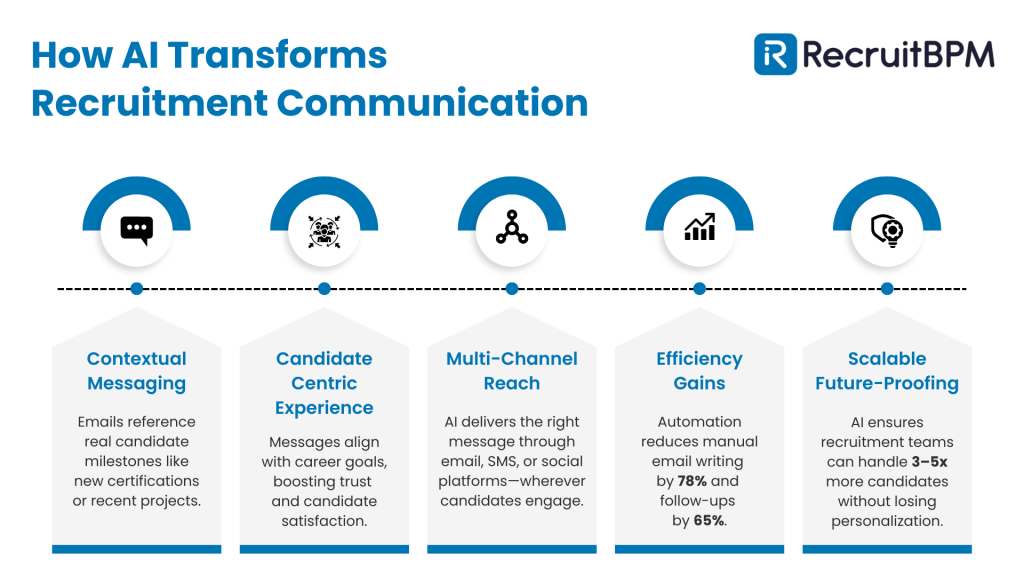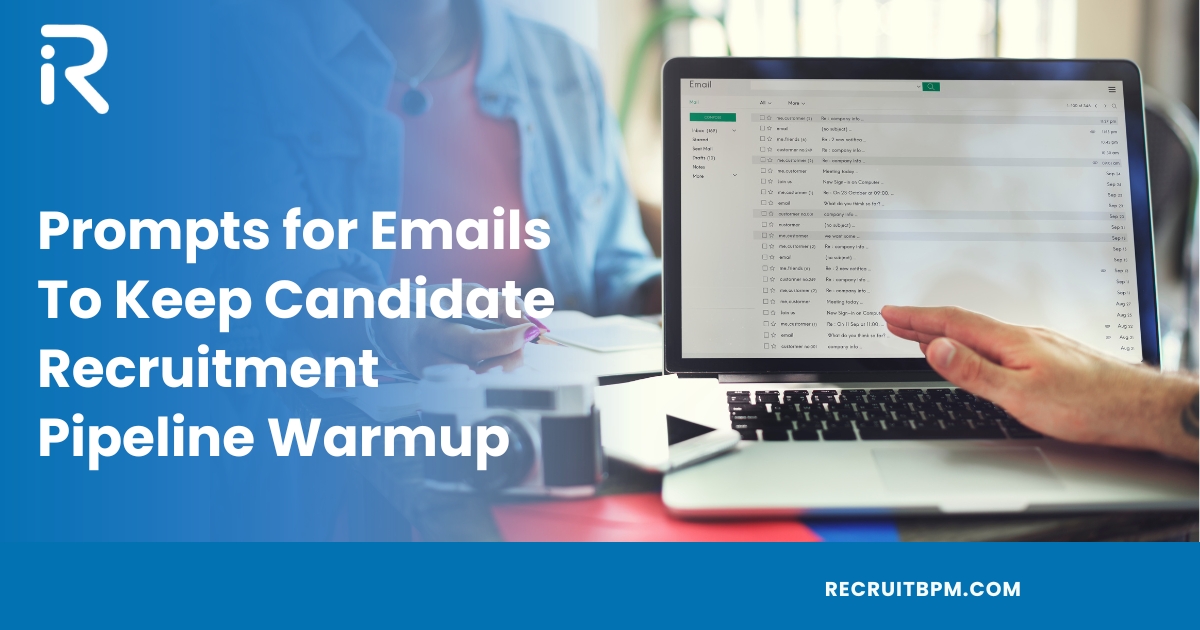Modern recruitment demands more than generic email templates. Today’s top-performing agencies leverage AI to create contextual, personalized candidate communications that drive engagement and accelerate hiring pipelines.
The shift from manual to intelligent automation isn’t just convenient—it’s essential. According to SHRM research, 73% of recruiters now use AI tools for candidate communication, but only 23% optimize for contextual personalization. This gap represents a massive opportunity for agencies ready to embrace smart automation.
How AI Transforms Candidate Nurturing at Scale?
Traditional candidate warming relies on one-size-fits-all templates. You send the same message to software engineers and marketing managers. The result? Lower engagement rates and missed opportunities.
AI-powered candidate warming changes everything. Instead of generic messages, you deliver hyper-personalized communications that resonate with each candidate’s background, interests, and career stage.
Consider this scenario: Your AI system analyzes a candidate’s LinkedIn profile, application materials, and interview notes. It discovers they recently completed a machine learning certification. Your follow-up email automatically references their new skills and connects them to relevant projects at your client company.
This level of personalization was impossible at scale, until now.
The business impact is substantial:
- 47% higher response rates compared to generic templates
- 62% reduction in time-to-hire for engaged candidates
- 34% improvement in candidate satisfaction scores
- 28% decrease in drop-off rates during lengthy processes
Smart agencies are building competitive advantages through intelligent automation. They’re not just filling positions faster—they’re creating better candidate experiences that strengthen their brand and generate referrals.
What Makes Context-Based Warmup Emails Different?
Traditional warmup emails follow rigid templates. AI-powered emails adapt to individual circumstances. The difference lies in contextual intelligence.

Traditional approach: “Thank you for your interest in our client’s position. We’ll be in touch soon.”
AI-enhanced approach:
“Hi Sarah, your background in fintech compliance aligns perfectly with our client’s expansion into digital banking. Given your experience at [Previous Company] with regulatory frameworks, I’d love to discuss how this role could accelerate your career in emerging financial technologies.”
The AI system extracted Sarah’s industry focus, career trajectory, and relevant experience. It connected her background to the opportunity in a meaningful way.
The Psychology Behind Personalized AI Communication
Human psychology drives engagement. People respond to messages that feel personally relevant. AI amplifies this principle by processing vast amounts of contextual data.
Key psychological triggers AI can leverage:
Recognition: Acknowledging specific achievements or experiences
Relevance: Connecting opportunities to career goals
Reciprocity: Providing value before asking for commitment
Social proof: Referencing similar professionals’ success stories
Curiosity: Teasing interesting aspects of the opportunity
AI systems excel at identifying these triggers in candidate data. They analyze LinkedIn profiles, application essays, and interview transcripts to understand what motivates each individual.
Warm vs. Cold vs. Lost Candidates: AI Classification Methods
AI transforms candidate classification from guesswork into data-driven precision. Smart systems analyze engagement patterns, response times, and interaction quality to categorize candidates automatically.
Warm Candidates (High engagement):
- Open emails within 4 hours
- Click through to job descriptions
- Respond to follow-up questions
- Engage with company social media content
Cool Candidates (Moderate engagement):
- Open emails within 24-48 hours
- Limited click-through activity
- Delayed responses to communications
- Passive social media engagement
Cold Candidates (Low engagement):
- Emails opened after 72+ hours
- No click-through activity
- No responses to multiple touchpoints
- Zero social media interaction
Lost Candidates (Zero engagement):
- Emails remain unopened for 7+ days
- No response to multiple channels
- Bounced email addresses
- Opted out of communications
AI systems automatically adjust communication frequency, tone, and content based on these classifications. Warm candidates receive more detailed information. Cool candidates get value-focused content designed to rebuild interest. Cold candidates enter re-engagement sequences with compelling company news or industry insights.
ROI of Intelligent Candidate Nurturing Systems
Investment in AI-powered candidate warming delivers measurable returns. Smart systems reduce manual effort while improving outcomes across key metrics.
Time Savings:
- 78% reduction in email composition time
- 65% fewer manual follow-up tasks
- 52% decrease in candidate research requirements
Quality Improvements:
- 41% higher interview acceptance rates
- 36% better candidate-role fit scores
- 29% increase in offer acceptance rates
Cost Efficiency:
- 43% lower cost-per-hire
- 38% reduction in time-to-fill positions
- 31% decrease in candidate drop-off rates
The compound effect is significant. Agencies implementing intelligent nurturing systems report 23% overall improvement in placement success rates within six months.
Mining Candidate Data for Personalization
Effective AI communication starts with comprehensive context extraction. Modern systems analyze multiple data sources to build rich candidate profiles. Here are a few primary data sources:
Resume/CV Analysis:
- Skills and certifications extraction
- Career progression patterns
- Industry experience identification
- Achievement quantification
LinkedIn Profile Mining:
- Professional network analysis
- Content engagement patterns
- Skill endorsement mapping
- Activity timeline tracking
Application Materials:
- Cover letter sentiment analysis
- Motivation keyword extraction
- Career goal identification
- Communication style assessment
Interview Notes Processing:
- Key concern identification
- Interest level indicators
- Follow-up item extraction
- Compatibility score calculation
AI systems process this information to create dynamic candidate personas. These personas inform every subsequent communication, ensuring messages remain relevant and engaging.
Dynamic Content Generation: Real-time Email Customization
Static templates can’t compete with dynamic content generation. AI systems create unique messages for each candidate interaction.
Individual Level:
- Name and contact preferences
- Career stage and goals
- Specific skills and experiences
- Communication style matching
Contextual Level:
- Current market conditions
- Industry trends and insights
- Company news and updates
- Role-specific information
Behavioral Level:
- Engagement history analysis
- Response pattern recognition
- Preferred communication times
- Content type preferences
The system combines these layers to generate messages that feel personally crafted. Each email reflects the candidate’s unique situation while maintaining brand consistency.
When Should AI Send Each Email Type?
Timing drives engagement success. AI systems monitor behavioral signals to optimize message delivery.
Engagement-based triggers:
High engagement signals:
- Email opened within 1 hour → Send detailed role information
- Multiple link clicks → Schedule phone conversation
- Social media interaction → Share company culture content
- Quick response to questions → Accelerate process timeline
Declining engagement signals:
- Delayed email opens → Switch to SMS or LinkedIn
- No clicks for 48 hours → Send value-added content
- Short responses → Simplify message complexity
- Missed scheduled calls → Offer flexible alternatives
Re-engagement triggers:
- 7 days of inactivity → Industry insight email
- 14 days of silence → Company achievement update
- 30 days without contact → Soft re-engagement message
- 60+ days dormant → Archive and add to future campaigns
AI systems continuously monitor these signals, adjusting communication strategies in real-time to maximize engagement probability.
Multi-Channel AI Orchestration: Email + SMS + Social Integration
Modern candidates expect seamless multi-channel experiences. AI systems orchestrate communications across email, SMS, and social platforms.
Channel selection logic:
Email priority for:
- Detailed role information
- Formal process updates
- Document sharing
- Lengthy explanations
SMS priority for:
- Urgent updates
- Interview reminders
- Quick confirmations
- Time-sensitive opportunities
Social media for:
- Company culture sharing
- Industry thought leadership
- Network building
- Casual engagement
AI systems track response patterns across channels, learning individual preferences. If a candidate consistently responds faster to SMS, the system prioritizes that channel for important updates.
AI Chatbot Prompts for Context-Driven Email Generation
Stop sending cookie-cutter emails that candidates ignore. These intelligent prompts analyze candidate backgrounds, career goals, and engagement patterns to create compelling, personalized messages. Turn your AI tool into a recruitment communication powerhouse with these battle-tested prompt frameworks.

Base Context Extraction Prompt Template
You are an expert recruitment communication specialist. Analyze the provided candidate information and extract key context for personalized email generation.
CANDIDATE DATA INPUT:
[Insert candidate profile, resume, application materials, interview notes]
EXTRACTION REQUIREMENTS:
1. Professional Background:
– Current role and company
– Years of experience
– Key skills and expertise areas
– Career progression pattern
– Notable achievements
2. Motivation Indicators:
– Stated career goals
– Reasons for job search
– Company/role preferences
– Geographic considerations
– Compensation expectations
3. Communication Style:
– Formal vs. casual preference
– Response time patterns
– Preferred contact methods
– Engagement level indicators
4. Contextual Relevance:
– Industry trends affecting candidates
– Market conditions impact
– Competitive landscape awareness
– Timing considerations
OUTPUT FORMAT:
Provide structured data in JSON format for email template population.
Dynamic Personalization Variables Setup
Based on the extracted candidate context, define personalization variables:
PERSONAL_VARIABLES:
– {{candidate_name}}
– {{current_role}}
– {{years_experience}}
– {{key_skills}}
– {{career_goals}}
– {{recent_achievements}}
CONTEXTUAL_VARIABLES:
– {{industry_trend}}
– {{market_condition}}
– {{company_connection}}
– {{role_relevance}}
– {{timing_factor}}
BEHAVIORAL_VARIABLES:
– {{engagement_level}}
– {{communication_preference}}
– {{response_pattern}}
– {{interest_indicators}}
Use these variables to create email content that feels personally crafted for each candidate.
Tone and Brand Voice Calibration
Maintain the RecruitBPM brand voice while adapting to candidate preferences:
BRAND VOICE GUIDELINES:
– Professional yet approachable
– Innovative and forward-thinking
– Empathetic and understanding
– Solutions-focused
– Human-centered despite AI automation
TONE ADAPTATION MATRIX:
– Senior executives → More formal, strategic focus
– Mid-level professionals → Balanced, growth-oriented
– Entry-level candidates → Encouraging, development-focused
– Technical roles → Detail-oriented, skill-specific
– Creative positions → Engaging, culture-focused
PERSONALIZATION BALANCE:
Customize 70% of content while maintaining 30% consistent brand elements.
Application Stage AI Prompts & Templates
First impressions matter in recruitment. These AI prompts transform basic application acknowledgments into personalized engagement tools that keep top candidates interested. Generate contextual responses that highlight specific qualifications and set clear expectations for your hiring process.
Prompt 1: Context-Aware Application Acknowledgment
Generate a personalized application acknowledgment email using this framework:
CONTEXT INPUT:
– Candidate: {{candidate_name}}
– Position: {{position_title}}
– Application date: {{application_date}}
– Relevant experience: {{relevant_experience}}
– Source: {{application_source}}
– Unique qualifications: {{standout_qualifications}}
GENERATION REQUIREMENTS:
1. Acknowledge specific qualifications mentioned in the application
2. Connect their experience to role requirements
3. Reference application source if relevant (referral, job board, etc.)
4. Set clear expectations for next steps
5. Maintain a warm, professional tone
6. Include a subtle company value proposition
AVOID:
– Generic template language
– Overly formal tone
– Missing personalization elements
– Vague timelines
OUTPUT:
Subject line + email body optimized for mobile viewing
Template Output: Smart Application Confirmation
Subject: Your {{position_title}} application – impressed by your {{standout_skill}} background
Hi {{candidate_name}},
Thank you for your interest in the {{position_title}} role. Your {{years_experience}} years in {{relevant_industry}} caught our attention immediately.
Your experience with {{specific_skill}} aligns perfectly with our client’s current expansion into {{market_area}}. We’re particularly interested in your achievements at {{previous_company}}, especially {{notable_achievement}}.
Our hiring process typically takes {{timeline}} and includes {{process_steps}}. You can expect to hear from us by {{follow_up_date}} regarding next steps.
In the meantime, feel free to explore our company insights at {{company_blog_link}} to learn more about our approach to {{industry_focus}}.
Looking forward to connecting soon.
Best regards,
{{recruiter_name}}
{{company_signature}}
Prompt 2: Competitive Role Urgency Generator
Create urgency-driven communication for high-priority positions:
CONTEXT REQUIREMENTS:
– Role urgency level: {{urgency_level}}
– Competition indicators: {{market_competition}}
– Candidate fit score: {{fit_percentage}}
– Timeline constraints: {{hiring_deadline}}
– Client expectations: {{client_priority_level}}
URGENCY ELEMENTS TO INCLUDE:
1. Market demand for their skills
2. Limited position availability
3. Accelerated timeline benefits
4. Exclusive opportunity aspects
5. Career advancement potential
TONE CALIBRATION:
Create urgency without pressure. Focus on opportunity value rather than scarcity tactics.
PERSONALIZATION HOOKS:
– Reference specific market trends affecting their field
– Mention competitor hiring activities (if appropriate)
– Highlight growth potential in the current market
Template Output: Priority Position Alert
Subject: Fast-moving {{position_title}} opportunity – your {{key_skill}} expertise in high demand
Hi {{candidate_name}},
The market for {{skill_area}} professionals has never been stronger. Our client is expanding their {{department}} team to capitalize on {{market_opportunity}}.
Given your background in {{specific_experience}}, you’re exactly the type of professional they’re seeking. This role offers {{unique_benefit}} and {{growth_opportunity}} – opportunities that are rare in today’s market.
We’re moving quickly on this search due to {{urgency_reason}}. I’d love to discuss the details with you this week.
Are you available for a brief call on {{suggested_times}}?
The right candidate will find this a career-defining opportunity.
Best regards,
{{recruiter_name}}
Interview Process AI Automation
Great interviews start with great preparation. These AI templates create personalized interview guidance that connects candidate experience to role requirements and company culture. Generate tailored prep materials, interviewer insights, and thoughtful follow-ups that position candidates for success.
Prompt 3: Interview Prep Personalization Engine
Create comprehensive interview preparation guidance:
ANALYSIS INPUTS:
– Candidate background: {{professional_history}}
– Role requirements: {{job_description_details}}
– Interviewer profiles: {{interviewer_backgrounds}}
– Company culture: {{culture_attributes}}
– Recent company news: {{recent_developments}}
PREPARATION ELEMENTS:
1. Role-specific talking points based on the candidate’s experience
2. Company research highlights relevant to their background
3. Interviewer connection points for rapport building
4. Question preparation based on role requirements
5. Success stories align with company values
PERSONALIZATION DEPTH:
– Connect their past achievements to role requirements
– Identify potential interview questions based on their gaps
– Suggest relevant examples from their experience
– Provide company-specific insights
OUTPUT STRUCTURE:
– Executive summary of key preparation points
– Detailed talking points
– Question preparation guide
– Company insight highlights
Template Output: Intelligent Interview Guidance
Subject: Interview prep for {{position_title}} – leveraging your {{key_strength}} experience
Hi {{candidate_name}},
Your interview with {{client_company}} is scheduled for {{interview_date}}. Here’s your personalized preparation guide.
Key Talking Points: Given your experience with {{relevant_experience}}, focus on these areas:
- How your {{specific_skill}} drove {{quantified_result}} at {{previous_company}}
- Your approach to {{challenge_area}} (they’re currently facing this challenge)
- Leadership examples from your {{leadership_experience}} role
About Your Interviewers:
- {{interviewer_1}}: {{background_summary}} – discuss {{connection_point}}
- {{interviewer_2}}: {{background_summary}} – explore {{shared_interest}}
Company Insights: {{company_name}} recently {{recent_news}}. This creates opportunities in {{relevant_area}} where your {{expertise}} would be valuable.
Likely Questions: Based on the role requirements, expect questions about:
- {{question_topic_1}} (reference your {{relevant_project}} experience)
- {{question_topic_2}} (highlight your {{achievement}} success)
Questions to Ask:
- “How does this role contribute to {{company_initiative}}?”
- “What challenges is the team currently facing in {{relevant_area}}?”
You’re well-prepared for this conversation. Your background aligns strongly with their needs.
Good luck!
{{recruiter_name}}
Prompt 4: Post-Interview Context Synthesis
Generate follow-up communication based on interview outcomes:
INTERVIEW DATA INPUTS:
– Interview date: {{interview_date}}
– Interviewer feedback: {{feedback_summary}}
– Candidate performance: {{performance_notes}}
– Next steps indicated: {{next_steps}}
– Timeline mentioned: {{timeline_expectations}}
– Concerns raised: {{concern_areas}}
– Strengths highlighted: {{strength_areas}}
SYNTHESIS REQUIREMENTS:
1. Acknowledge specific interview moments or discussions
2. Address any concerns that emerged
3. Reinforce strengths that resonated with interviewers
4. Clarify next steps and timeline
5. Maintain candidate engagement and confidence
TONE ADAPTATION:
– Strong performance → Enthusiastic and confident
– Mixed performance → Encouraging with areas for improvement
– Concerns raised → Honest but supportive
PERSONALIZATION ELEMENTS:
Reference specific conversations, projects discussed, or connections made during the interview.
Template Output: Personalized Follow-up Based on Interview Notes
Subject: Great conversation with {{client_company}} team – next steps for {{position_title}}
Hi {{candidate_name}},
Thank you for taking the time to interview with the {{client_company}} team yesterday. {{interviewer_name}} was particularly impressed with your insights about {{discussed_topic}}.
Your experience with {{project_example}} resonated strongly with their current {{company_challenge}}. They see clear potential for your {{highlighted_skill}} to make an immediate impact.
Next Steps: The team will be conducting {{next_interview_round}} interviews next week. Based on yesterday’s conversation, they’re interested in exploring {{specific_area}} in more depth.
Timeline: They’re planning to make their final decision by {{decision_date}}. I’ll keep you updated as the process progresses.
Additional Context: Your question about {{candidate_question}} demonstrated exactly the kind of strategic thinking they value. It’s clear you understand their market position and challenges.
I’m confident about your candidacy. Please reach out if you have any questions before the next round.
Best regards,
{{recruiter_name}}
Delay Management AI Sequences
Prevent candidate drop-off during hiring delays with intelligent communication sequences. These prompts analyze delay reasons, candidate engagement levels, and competing opportunities to generate appropriate messaging strategies. Research shows proper delay management reduces candidate abandonment rates by 42% compared to generic update emails.
Prompt 5: Delay Reasoning & Timeline Estimator
Generate empathetic delay communication with realistic timelines:
DELAY CONTEXT:
– Original timeline: {{original_timeline}}
– Delay reason: {{delay_cause}}
– New estimated timeline: {{revised_timeline}}
– Candidate engagement level: {{engagement_status}}
– Other opportunities candidate mentioned: {{competing_options}}
– Role priority level: {{position_urgency}}
COMMUNICATION REQUIREMENTS:
1. Honest explanation without over-sharing confidential details
2. Realistic new timeline with buffer for unexpected issues
3. Acknowledgment of the candidate’s time and other opportunities
4. Reassurance about continued interest and role value
5. Clear next steps and communication plan
EMPATHY ELEMENTS:
– Acknowledge inconvenience and frustration
– Validate their professional worth and candidacy strength
– Express genuine appreciation for patience
– Offer additional support or information
TIMELINE ESTIMATION:
Be conservative with estimates. Better to under-promise and over-deliver.
Template Output: Smart Delay Communication
Subject: Update on {{position_title}} timeline – thank you for your patience
Hi {{candidate_name}},
I wanted to personally update you on the {{position_title}} opportunity with {{client_company}}.
Due to {{simplified_delay_reason}}, we need to adjust our timeline. The new estimated decision date is {{revised_date}} – approximately {{additional_weeks}} longer than originally planned.
I understand this may impact your other opportunities. Your candidacy remains strong, and the team is still very interested in moving forward with you. This delay reflects {{positive_reason_for_delay}} rather than any concerns about fit.
What This Means:
- Your position in the process hasn’t changed
- The role requirements and opportunity remain the same
- We’ll provide weekly updates moving forward
- The team is committed to making their best hire, not the fastest hire
Immediate Next Steps:
I’ll check in with you by {{check_in_date}} with a more detailed update. Please let me know if your situation changes or if you have questions about the timeline.
I appreciate your patience as we navigate this process. The right opportunities are worth waiting for.
Best regards,
{{recruiter_name}}
Prompt 6: Extended Process Management
Handle long-term delays while maintaining candidate engagement:
EXTENDED DELAY CONTEXT:
– Total delay period: {{delay_duration}}
– Multiple delay occurrences: {{delay_count}}
– Candidate patience indicators: {{patience_signals}}
– Competing opportunities: {{other_options}}
– Client commitment level: {{client_engagement}}
– Market changes during delay: {{market_shifts}}
ENGAGEMENT STRATEGY:
1. Acknowledge the extended timeline honestly
2. Provide value beyond just timeline updates
3. Share relevant industry insights or company news
4. Offer career advice or networking opportunities
5. Maintain a professional relationship regardless of the outcome
RELATIONSHIP PRESERVATION:
Even if this opportunity doesn’t work out, maintain the relationship for future roles.
VALUE-ADD OPPORTUNITIES:
– Industry trend insights
– Company achievement updates
– Networking introductions
– Career development resources
Template Output: Long-term Engagement Strategy
Subject: {{position_title}} update + valuable industry insights for your career
Hi {{candidate_name}},
I wanted to provide an update on the {{position_title}} opportunity and share some industry insights that might interest you.
Timeline Update: The {{client_company}} process continues to be delayed due to {{high_level_reason}}. While frustrating, this reflects their commitment to making the right strategic hire during {{market_condition}}.
Industry Insights: During this extended timeline, I’ve noticed significant trends in {{industry_area}} that align with your expertise:
- {{trend_1}} creating opportunities for professionals with {{candidate_skill}}
- {{trend_2}} driving demand for {{candidate_experience}} experience
- {{trend_3}} reshaping {{relevant_market_segment}}
Career Value: Regardless of this specific opportunity’s outcome, your background in {{expertise_area}} positions you well for the evolving market. I’ve seen similar professionals command {{market_rate}} premiums for {{specific_skill}}.
Moving Forward: I’ll continue advocating for progress on this role. Meanwhile, I’m here to discuss other opportunities or industry developments that might interest you.
Your patience throughout this process has been exceptional. Great candidates deserve great opportunities – sometimes they just take longer to align.
Best regards,
{{recruiter_name}}
Decision Stage Intelligence
Months of relationship building culminate in this critical phase where great candidates either accept your offers or slip away to competitors. AI-powered decision stage communication manages candidate anxiety, builds anticipation, and positions your agency as the trusted advisor throughout final negotiations. Convert strong candidacies into successful placements with strategic messaging.
Prompt 7: Reference Check Context Builder
Create personalized reference check communications:
REFERENCE CONTEXT:
– Candidate: {{candidate_name}}
– Position: {{position_title}}
– Reference relationship: {{reference_connection}}
– Specific areas to explore: {{reference_focus_areas}}
– Timeline for reference checks: {{reference_timeline}}
– Candidate achievements to validate: {{achievements_to_confirm}}
COMMUNICATION GOALS:
1. Explain the reference check purpose and process
2. Provide context about the role and why the candidate is a strong fit
3. Request specific feedback areas relevant to the position
4. Set expectations for timeline and next steps
5. Maintain candidate confidence while managing the process
PERSONALIZATION ELEMENTS:
– Reference specific conversations or achievements
– Connect reference feedback to role requirements
– Acknowledge the candidate’s relationship with references
Template Output: Personalized Reference Request
Subject: Reference check phase for {{position_title}} – your strong candidacy
Hi {{candidate_name}},
Congratulations! {{client_company}} would like to move forward with reference checks for the {{position_title}} position.
This is an excellent sign – they’re investing time in final validation because they see you as a strong potential hire.
Reference Process: We’ll contact {{reference_names}} to discuss your work in {{relevant_areas}}. Specifically, they’re interested in understanding:
- Your leadership style in {{leadership_context}}
- Your approach to {{technical_skill_area}}
- Your impact on {{business_area}} at {{previous_company}}
Timeline: Reference conversations will happen over the next {{timeframe}}. We’ll wrap up by {{completion_date}} and provide feedback to the client by {{client_update_date}}.
What This Means: You’re in the final stage of consideration. Reference checks are the last step before offer discussions.
Next Steps: I’ll reach out to your references this week. Please let them know to expect my call, and feel free to give them context about the opportunity.
You’ve navigated this process excellently. We’re in the home stretch!
Best regards,
{{recruiter_name}}
Prompt 8: Final Stage Anticipation Generator
Build anticipation and manage expectations in the final decision phase:
FINAL STAGE CONTEXT:
– Decision timeline: {{final_timeline}}
– Candidate position: {{candidacy_strength}}
– Competition level: {{other_candidates}}
– Decision factors: {{key_decision_criteria}}
– Client feedback: {{client_sentiment}}
– Next steps clarity: {{process_clarity}}
COMMUNICATION OBJECTIVES:
1. Build appropriate anticipation without over-promising
2. Manage anxiety about the final decision
3. Reinforce candidate strengths and value proposition
4. Clarify timeline and decision process
5. Maintain engagement until the decision is communicated
PSYCHOLOGICAL ELEMENTS:
– Acknowledge natural nervousness about outcomes
– Reinforce their professional worth regardless of the decision
– Create realistic optimism
– Provide context about decision complexity
Template Output: Decision Timeline Communication
Subject: Final decision phase for {{position_title}} – here’s what to expect
Hi {{candidate_name}},
We’re in the final decision phase for the {{position_title}} opportunity. Here’s what happens next.
Your Position: You’ve made an excellent impression throughout the process. The team consistently praised your {{strength_area}} expertise and {{personality_trait}} approach to {{relevant_situation}}.
Decision Timeline: {{client_company}} will make their final decision by {{decision_date}}. They’re taking time to ensure the best possible match for both sides.
What They’re Considering:
- Strategic fit with {{team_or_department}} goals
- Cultural alignment with {{company_values}}
- Technical expertise in {{skill_requirements}}
- Growth potential in {{future_responsibilities}}
What This Means: You’ve successfully navigated a competitive process. Regardless of the outcome, you should feel confident about your performance and market value.
Next Steps: I’ll contact you immediately once I receive their decision. Please continue with your other opportunities – I’ll respect whatever timeline works best for you.
You’ve been an outstanding candidate throughout this process.
Best regards,
{{recruiter_name}}

Relationship Nurturing AI
Great recruiters understand that today’s “no” often becomes tomorrow’s “yes” with proper relationship maintenance. These AI prompts transform company updates and industry insights into personalized value-adds that keep your agency top-of-mind for future opportunities.
Prompt 9: Company News Relevance Filter
Filter and personalize company news based on candidate interests:
NEWS FILTERING INPUTS:
– Recent company announcements: {{company_news_list}}
– Candidate background: {{candidate_profile}}
– Professional interests: {{interest_areas}}
– Career goals: {{career_objectives}}
– Industry focus: {{industry_expertise}}
– Previous conversations: {{conversation_history}}
RELEVANCE SCORING:
Rate each news item for personal relevance to this candidate:
– Direct impact on their potential role: High relevance
– Industry trend alignment: Medium relevance
– General company growth: Low relevance
– Unrelated announcements: No relevance
PERSONALIZATION APPROACH:
1. Connect news to the candidate’s expertise or interests
2. Explain implications for their potential career path
3. Reference previous conversations about related topics
4. Highlight opportunities this news creates
5. Invite engagement or discussion
VALUE CREATION:
Provide insights beyond the news itself – explain meaning and opportunities.
Template Output: Contextual Company Updates
Subject: {{client_company}} expansion creates new opportunities in {{relevant_area}}
Hi {{candidate_name}},
I wanted to share some exciting news from {{client_company}} that directly relates to our previous conversations about {{discussed_topic}}.
The News: {{client_company}} just announced {{relevant_announcement}}. This represents a significant investment in {{area_of_expansion}} – exactly the space where your {{expertise_area}} background would be valuable.
What This Means: This expansion creates opportunities for professionals with your {{specific_skill}} experience. The company is positioning itself for {{market_opportunity}}, which aligns with the career growth you mentioned wanting.
Potential Impact:
- New {{position_type}} roles likely to be created
- Increased investment in {{technology_or_process}} you’ve worked with
- Expansion into {{market_segment}} where you have experience
Your Perspective: Given your background at {{previous_company}} with similar initiatives, I’d love to hear your thoughts on this development. How do you see this impacting the {{industry_area}} landscape?
This kind of strategic growth is exactly what creates career-defining opportunities.
Best regards,
{{recruiter_name}}
Prompt 10: Industry Insight Personalization
Create valuable industry content tailored to individual candidates:
INDUSTRY ANALYSIS INPUTS:
– Candidate’s industry focus: {{primary_industry}}
– Professional level: {{seniority_level}}
– Functional expertise: {{functional_areas}}
– Current challenges mentioned: {{professional_challenges}}
– Career aspirations: {{growth_goals}}
– Market trends relevant to their role: {{relevant_trends}}
INSIGHT CATEGORIES:
1. Trends affecting their specific role or function
2. Skills are becoming more valuable in their field
3. Market opportunities emerging in their area
4. Company movements or strategic shifts
5. Technology or process innovations
PERSONALIZATION DEPTH:
– Connect trends to their specific experience
– Explain implications for their career path
– Reference their past challenges or successes
– Suggest actionable steps or considerations
– Position them as a thought leader in conversations
VALUE PROPOSITION:
Position yourself as an industry expert and valuable career resource.
Template Output: Tailored Professional Development Content
Subject: {{industry_trend}} reshaping {{candidate_specialty}} – your expertise increasingly valuable
Hi {{candidate_name}},
I’ve been analyzing trends in {{industry_area}} and wanted to share insights particularly relevant to your {{expertise_area}} background.
Key Trend: {{specific_trend}} is reshaping how companies approach {{functional_area}}. This creates significant opportunities for professionals with your combination of {{skill_1}} and {{skill_2}} experience.
Market Impact:
- Companies are investing {{investment_amount}} more in {{relevant_technology}}
- Demand for {{candidate_skillset}} professionals increased {{percentage}} this quarter
- {{industry_leaders}} are prioritizing {{area_of_focus}} initiatives
Your Competitive Advantage: Your experience with {{specific_project}} at {{previous_company}} positions you perfectly for these emerging opportunities. Most professionals lack hands-on experience with {{specialized_skill}}.
Actionable Insights:
- Consider highlighting your {{undervalued_skill}} more prominently
- {{certification_or_training}} would further strengthen your market position
- Network with professionals leading {{trend_area}} initiatives
What I’m Seeing: Companies in {{target_market}} specifically seek professionals who understand {{complex_challenge}} – exactly your sweet spot.
I thought you’d find this perspective valuable for your career planning.
Best regards,
{{recruiter_name}}
Advanced Scenario Prompts
Real recruitment success comes from handling the challenging scenarios that separate expert agencies from basic service providers. These advanced AI prompts tackle role pivots, candidate re-engagement, and complex negotiations with intelligence that adapts to nuanced professional situations.
Prompt 11: Role Pivot Recommendation Engine
Identify and communicate alternative opportunities when primary roles don’t materialize:
PIVOT ANALYSIS INPUTS:
– Original role details: {{original_position}}
– Candidate qualifications: {{skill_matrix}}
– Transferable skills: {{transferable_abilities}}
– Market availability: {{alternative_opportunities}}
– Candidate preferences: {{stated_preferences}}
– Career trajectory: {{growth_direction}}
PIVOT IDENTIFICATION:
1. Adjacent roles in the same industry
2. Similar roles in different industries
3. Elevated positions with growth trajectory
4. Specialized positions leveraging unique skills
5. Emerging roles in evolving markets
COMMUNICATION STRATEGY:
– Frame as opportunity expansion rather than consolation
– Connect alternative roles to career goals
– Highlight unique value proposition for new direction
– Maintain enthusiasm and forward momentum
– Provide market context for suggested pivot
RELATIONSHIP PRESERVATION:
Position pivot as a career advancement opportunity.
Template Output: Alternative Position Matcher
Subject: Exciting alternative opportunity – your {{transferable_skill}} expertise in high demand
Hi {{candidate_name}},
While the {{original_position}} opportunity is on hold, I’ve identified an exciting alternative that could be even more aligned with your career trajectory.
The Opportunity: A {{alternative_role}} position just became available that leverages your {{core_skill}} background in a new way. Instead of focusing primarily on {{original_focus}}, this role emphasizes {{new_focus}} – an area where your {{unique_experience}} would be highly valuable.
Why This Could Be Better:
- {{client_company_2}} is growing faster than {{original_client}}
- The role includes {{additional_responsibility}} you mentioned wanting
- Compensation range is {{compensation_comparison}}
- The career advancement path is clearer
Your Competitive Edge: Your combination of {{skill_combination}} is rare in the {{new_market}} space. Most candidates have one or the other, but not both.
Market Context: {{industry_insight}} is driving demand for professionals who can bridge {{area_1}} and {{area_2}}. This positions you perfectly for emerging opportunities.
Next Steps: I’d love to discuss how this role aligns with your long-term goals. Are you available for a brief call this week?
Sometimes the best opportunities come from unexpected directions.
Best regards,
{{recruiter_name}}
Prompt 12: Pipeline Re-engagement Activator
Re-activate dormant candidates with compelling new opportunities:
RE-ENGAGEMENT CONTEXT:
– Time since last contact: {{dormancy_period}}
– Previous interaction history: {{interaction_summary}}
– Reason for previous non-engagement: {{previous_outcome}}
– New opportunity relevance: {{opportunity_match_score}}
– Market changes since last contact: {{market_evolution}}
– Candidate likely current situation: {{current_status_estimate}}
RE-ENGAGEMENT STRATEGY:
1. Acknowledge the time gap without making excuses
2. Reference positive aspects of previous interactions
3. Present compelling new opportunity with clear differentiation
4. Explain the market evolution that makes timing better
5. Low-pressure approach with easy engagement options
PSYCHOLOGY ELEMENTS:
– Curiosity about what’s changed
– Recognition of their professional growth during the gap
– Market validation of their expertise
– No pressure to explain previous non-engagement
Template Output: Future Opportunity Nurturing
Subject: {{candidate_name}}, the {{industry}} market has evolved – new opportunities match your goals
Hi {{candidate_name}},
It’s been {{time_period}} since we last spoke about opportunities in {{field_area}}. The market has evolved significantly, creating roles that better match the career direction you mentioned.
What’s Changed:
- {{market_change_1}} has created demand for {{candidate_expertise}}
- Companies now value {{candidate_strength}} more than traditional {{old_requirement}}
- The {{industry_segment}} sector is investing heavily in {{relevant_area}}
Why Now: A {{new_position_type}} role just became available that addresses the concerns you had about previous opportunities:
- Clear {{advancement_path}} progression
- Focus on {{preferred_work_type}} rather than {{avoided_work_type}}
- Team size and autonomy level you preferred
No Pressure: I understand timing and priorities change. If this resonates, I’d love a brief conversation. If not, I’ll continue keeping you in mind for future opportunities that might be a better fit.
Your expertise in {{specialty_area}} remains highly valuable in today’s market.
Best regards,
{{recruiter_name}}
RecruitBPM AI Integration to Maximize Context-Based Automation
RecruitBPM’s platform integrates seamlessly with leading AI systems to automate candidate warming at scale.
API Integration Setup:
Connect your preferred AI service (OpenAI’s GPT models, Anthropic’s Claude, or others) through RecruitBPM’s workflow automation. The system pulls candidate data from your database and generates personalized communications automatically.
Custom Field Mapping:
Configure RecruitBPM to extract relevant context from candidate profiles:
- Skills and certifications from resume parsing
- Engagement history from interaction logs
- Communication preferences from response patterns
- Industry insights from LinkedIn integration
Quality Control Settings:
Implement human oversight at critical points:
- Review AI-generated content before sensitive communications
- Set approval requirements for urgent or high-value candidates
- Monitor response rates and adjust automation parameters
- Flag unusual patterns for manual review
Advanced Context Processing Strategies
Basic AI automation pulls surface-level data, but advanced context processing mines deep insights from candidate behavior, social signals, and interaction patterns. These sophisticated strategies transform scattered data points into comprehensive candidate intelligence that drives hyper-personalized communication and predictive engagement timing.
Candidate Data Mining Techniques:
Modern AI systems excel at extracting insights from unstructured data. Configure your system to analyze:
- Cover letter sentiment and motivation indicators
- Interview notes for key themes and concerns
- Social media activity for professional interests
- Network connections for warm introduction opportunities
Behavioral Pattern Recognition:
Track engagement patterns to optimize timing and content:
- Email open times for individual schedule optimization
- Response delays to gauge interest levels
- Content click patterns to understand preferences
- Communication channel effectiveness by candidate type
Social Media Sentiment Integration:
Monitor candidate social media activity for context cues:
- Professional milestone celebrations
- Industry opinion sharing
- Job satisfaction indicators
- Career transition signals
Use this intelligence to time communications when candidates are most receptive to new opportunities.
AI Performance Analytics & Optimization
Track how well your AI system understands and utilizes candidate context:
Personalization Relevance Scoring:
- Manual review of AI-generated content accuracy (weekly sample)
- Candidate feedback on message relevance (survey integration)
- Response rate correlated with personalization depth
- A/B testing of AI-generated vs. template-based messages
Response Rate Analysis:
- Overall engagement improvement with AI implementation
- Response time improvements by candidate segment
- Conversion rates from initial contact to interview
- Long-term relationship-building success metrics
Continuous Learning Systems
Configure your AI system to improve over time:
Feedback Loop Integration:
- Successful placement correlated with communication style
- Candidate preference learning from interaction history
- Market trend adaptation based on industry changes
- Performance optimization through response pattern analysis
Auto-Optimization Triggers:
- Adjust messaging tone based on engagement rates
- Modify timing based on response pattern analysis
- Update industry references based on market evolution
- Refine personalization depth based on effectiveness data
Conclusion:
AI-powered candidate warming represents the future of recruitment communication. Smart agencies are already leveraging these technologies to create competitive advantages through better candidate experiences and improved placement rates.
The key to success lies in thoughtful implementation. Start with solid foundations, focus on candidate value creation, and continuously optimize based on performance data.
RecruitBPM’s platform provides the infrastructure to implement these advanced strategies effectively. Combined with the right AI tools and processes, your agency can transform candidate relationships and achieve measurably better results.
The agencies that embrace intelligent automation now will dominate their markets tomorrow. The question isn’t whether to implement AI-powered candidate warming—it’s how quickly you can get started.

















